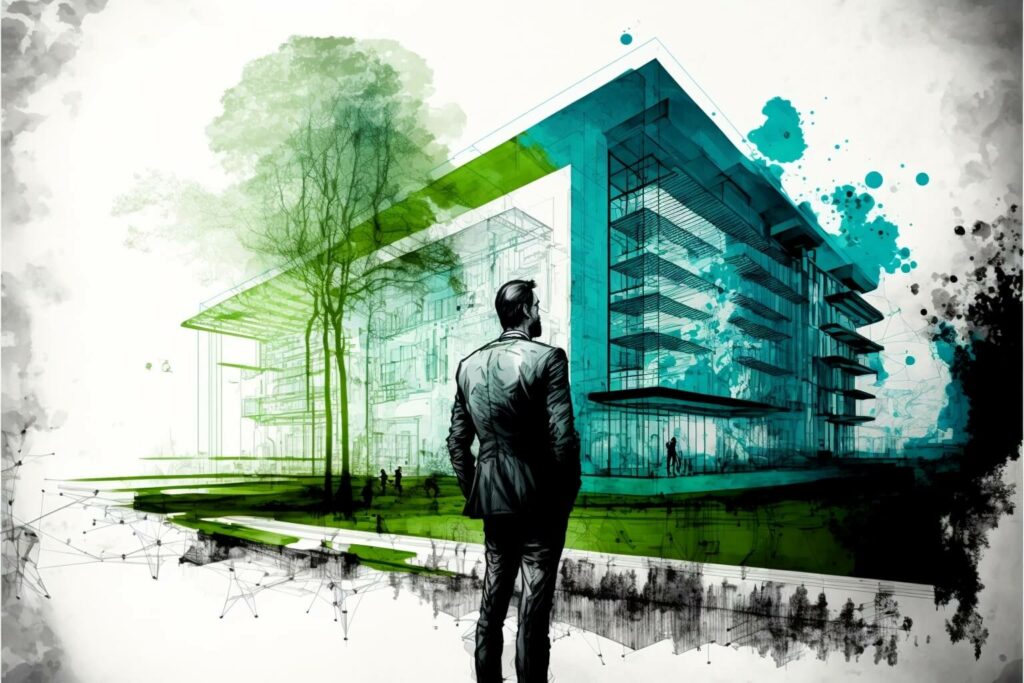Unlock Premium, Members-Only Content
Your source for the most relevant updates in sustainable construction
As the world faces increasing challenges such as climate change and resource depletion, there is a growing need for more sustainable and resilient infrastructure.
Sustainability engineering is a holistic approach that addresses environmental, social, and economic issues in infrastructure design, construction, and maintenance.
In this article, we will explore the current trends and prospects for sustainability engineering and how civil engineers are working to create an infrastructure that is more responsive to the needs of communities and the environment.
We invite you to learn more about this critical and rapidly evolving field.

What is sustainability engineering?
Sustainability engineering integrates environmental, social, and economic considerations into civil infrastructure design, construction, and maintenance. This includes everything from buildings and roads to bridges and water systems. sustainability engineering aims to create an infrastructure that meets the needs of the present without compromising the ability of future generations to meet their own needs.
Sustainability engineering takes into account the entire lifecycle of a project, from the selection of materials and the use of natural resources to the disposal or reuse of materials at the end of a project’s useful life. It also considers the impacts of a project on the local community and the environment and seeks to minimize these impacts where possible.
Sustainability engineering has many benefits, including reduced environmental impacts, improved resource efficiency, enhanced quality of life for communities, and cost savings.
In addition, by adopting sustainable practices, civil engineers can contribute to a more sustainable future and help to address global challenges such as climate change and resource depletion.
Overall, sustainability engineering is a critical and evolving field that plays a vital role in developing and maintaining our built environment.
By considering their projects’ environmental, social, and economic impacts, civil engineers can help create an infrastructure that is functional, durable, sustainable, and responsible.
How is sustainability incorporated into civil sustainability engineering projects?
Sustainability can be incorporated into civil engineering projects in many ways, including:
- Design for efficiency: sustainability engineering projects often incorporate design elements that maximize efficiency and minimize the use of resources. This can include using locally sourced, recycled, or renewable materials and designing buildings and infrastructure to maximize energy and water efficiency.
- Minimize environmental impacts: sustainability engineering projects seek to minimize their environmental impacts by reducing waste, minimizing the use of hazardous materials, and conserving natural resources. This can include strategies such as using sustainable materials, incorporating green spaces and natural features into the design, and implementing measures to mitigate the impact of construction activities.
- Consider the lifecycle of the project: sustainability engineering projects consider the entire project lifecycle, from the selection of materials and the use of natural resources to the disposal or reuse of materials at the end of a project’s useful life. This helps minimize a project’s environmental impacts and ensure that it is as sustainable as possible.
- Engage the community: sustainability engineering projects often involve the participation and input of the local community. This can help to ensure that the needs and priorities of the community are taken into account and that the project is responsive to local concerns.
Overall, sustainability can be incorporated into civil engineering projects, including designing for efficiency, minimizing environmental impacts, considering the project’s lifecycle, and engaging the community.
By adopting these practices, civil engineers can help to create an infrastructure that is sustainable and responsible.
Unlock Premium, Members-Only Content
Your source for the most relevant updates in sustainable construction
What are some examples of sustainability engineering projects?
There are many examples of sustainability engineering projects around the world. Here are a few examples:
- The Gateshead Millennium Bridge in the United Kingdom is a pedestrian and cyclist bridge powered by a kinetic energy recovery system (KERS). The KERS captures the energy generated by the bridge’s movement and stores it in a flywheel, which is then used to power the bridge’s lighting and other systems.
- The Eden Project in Cornwall, England, is a visitor attraction that features a series of geodesic domes that house a variety of plant species from around the world. The domes are made from a lattice of hexagonal and pentagonal cells clad in transparent plastic. The domes are designed to be energy efficient and autonomous, with rainwater collection and greywater systems, as well as solar panels and wind turbines.
- The Pearl Farm Beach Resort in Davao City, Philippines, is a sustainable resort built using locally sourced materials and incorporates many sustainable design features. The resort features a wastewater treatment plant, solar panels, a rainwater harvesting system, and some eco-friendly buildings and facilities.
- The San Francisco Public Utilities Commission’s Sunset Reservoir Solar Project is a solar power installation located on top of a drinking water reservoir in San Francisco, California. The project features more than 7,000 solar panels that generate clean electricity and provide shade for the reservoir, which helps to reduce evaporation and improve drinking water quality.
Overall, many examples of sustainability engineering projects worldwide demonstrate the potential for civil engineering to contribute to a more sustainable future.
From kinetic energy recovery systems and geodesic domes to solar power installations and eco-friendly buildings, these projects showcase the innovative and creative approaches that can be used to create sustainable infrastructure.
What are the benefits of sustainability engineering?
There are many benefits to sustainability engineering, including the following:
- Environmental benefits: sustainability engineering projects can help to reduce the environmental impacts of infrastructure development and maintenance. This can include minimizing waste, conserving natural resources, and reducing the use of hazardous materials.
- Resource efficiency: sustainability engineering projects are designed to be resource efficient, which means they use fewer resources and generate less waste than traditional projects. This can help reduce the demand for raw materials and energy and lead to cost savings.
- Enhanced quality of life: sustainability engineering projects can enhance the quality of life for communities by providing access to clean water, efficient transportation, and other essential services. These projects can also help create livable and healthy environments, improving public health and well-being.
- Cost savings: sustainability engineering projects can offer cost savings over the long term due to their resource efficiency and durability. For example, a building that is energy efficient may require less energy to operate, leading to lower energy bills and maintenance costs.
- Social and economic benefits: sustainability engineering projects can also provide social and economic benefits to communities. These projects can create jobs and stimulate local economies, and can also help to improve social cohesion and community resilience.
Overall, sustainability engineering has many benefits, including environmental, resource, and cost savings, enhanced quality of life, and social and economic benefits. In addition, by adopting sustainable practices, civil engineers can contribute to a more sustainable future and help to address global challenges such as climate change and resource depletion.

What are the challenges of implementing sustainability engineering?
Implementing sustainability engineering can present many challenges, including:
- Cost: One of the main challenges of implementing sustainability engineering is the cost. Sustainable infrastructure projects can often be more expensive to design and build than traditional projects, which can be a barrier to their adoption. This can be particularly challenging in resource-constrained or developing areas, where funding and other resources may be limited.
- Limited resources: Another challenge is the limited availability of resources such as funding, skilled labor, and materials. This can make it difficult to implement sustainable infrastructure projects, particularly in resource-constrained or developing areas.
- Complexity: Sustainable infrastructure projects can be complex and require the integration of multiple disciplines and stakeholders. This can make coordinating and managing these projects challenging and difficult to measure and demonstrate their impact.
- Regulation: sustainability engineering can be impacted by various regulations and standards, varying by region and sector. Ensuring compliance with these regulations can be challenging, particularly for innovative or pioneering new projects.
- Public perception: Another challenge is the public perception of sustainable infrastructure projects. Some people may be skeptical of or resistant to these projects, making it difficult to secure support and funding.
Overall, there are many challenges to implementing sustainability engineering. However, these challenges can be overcome by developing strategies to address them, such as finding ways to reduce costs, seeking funding and other resources, building partnerships and collaborations, and engaging with stakeholders and the public.
Civil engineers can help create a more sustainable infrastructure that meets present and future needs by overcoming these challenges.
Unlock Premium, Members-Only Content
Your source for the most relevant updates in sustainable construction
How can civil engineers contribute to sustainability engineering?
Civil engineers play a vital role in building and maintaining the infrastructure that underpins our communities and economies. By adopting sustainable practices, civil engineers can contribute to a more sustainable future and help to address global challenges such as climate change and resource depletion.
Here are a few ways that civil engineers can contribute to sustainability:
- Incorporate sustainability into the design and construction of infrastructure projects: Civil engineers can design infrastructure projects that are efficient and use sustainable materials, which can help reduce these projects’ environmental impacts. They can also consider the lifecycle of a project and design for reuse, recycling, and other sustainable practices.
- Use data and technology to optimize infrastructure performance: Civil engineers can use data and technology to monitor and optimize the performance of infrastructure projects. This can help identify opportunities for efficiency improvements and reduce these projects’ environmental impacts.
- Engage with communities and stakeholders: Civil engineers can engage with communities and stakeholders to ensure that their needs and concerns are considered in the design and implementation of infrastructure projects. This can help create projects more responsive to local needs and more likely to be supported by the community.
- Promote sustainable transportation options: Civil engineers can design and implement sustainable transportation options, such as bike lanes and public transit systems, which can help reduce transportation’s environmental impacts and improve the quality of life for communities.
- Support the development of renewable energy sources: Civil engineers can support the development of renewable energy sources, such as solar and wind power, which can help reduce reliance on fossil fuels and greenhouse gas emissions.
Overall, there are many ways that civil engineers can contribute to sustainability, including by incorporating sustainability into the design and construction of infrastructure projects, using data and technology to optimize performance, engaging with communities and stakeholders, promoting sustainable transportation options, and supporting the development of renewable energy sources.
By adopting these practices, civil engineers can play a vital role in building a more sustainable future.

What are the current trends in sustainability engineering?
Several sustainability engineering trends shape how infrastructure is designed, built, and maintained. Some of these trends include:
- Climate change adaptation: Civil engineers are increasingly focused on designing infrastructure that is resilient to the impacts of climate change, such as sea level rise, flooding, and extreme weather events. This can include preparing infrastructure to withstand these impacts and incorporating features that can help mitigate their effects.
- Resource efficiency: Civil engineers are also focused on designing more resource-efficient infrastructure, which means using fewer resources and generating less waste. This can include using locally sourced, recycled, or renewable materials and designing buildings and infrastructure to maximize energy and water efficiency.
- Green infrastructure: Green infrastructure refers to using natural systems, such as green roofs, rain gardens, and permeable pavements, to manage stormwater runoff and reduce the impacts of development on the environment. Civil engineers are increasingly incorporating green infrastructure into infrastructure projects to improve water quality and reduce the risk of flooding.
- Circular economy: The circular economy is an economic model that aims to reduce waste and resource depletion by designing products and systems that are reusable, recyclable, and regenerative. Civil engineers are exploring ways to apply the circular economy principles to infrastructure projects, such as designing for reuse and recycling and incorporating closed-loop systems.
- Smart infrastructure: Smart infrastructure refers to the use of technology and data to optimize infrastructure performance and improve the quality of life for communities. Civil engineers are exploring using sensors, IoT technologies, and other tools to monitor and manage infrastructure in real-time and improve efficiency.
Many sustainability engineering trends shape how infrastructure is designed, built, and maintained.
These trends are focused on addressing global challenges such as climate change and resource depletion and are helping to create more sustainable and resilient infrastructure for the future.
What are the goals of sustainability engineering?
Sustainability engineering aims to design, build, and maintain an environmentally responsible, socially equitable, and economically viable infrastructure. This can be achieved through a variety of practices and approaches, such as:
- Minimizing the environmental impacts of infrastructure development and maintenance: sustainability engineering aims to reduce the environmental impacts of infrastructure projects, such as air and water pollution, habitat destruction, and waste generation. This can be achieved through the use of sustainable materials, the incorporation of green infrastructure, and the optimization of resource use.
- Enhancing the quality of life for communities: sustainability engineering also aims to enhance the quality of life for communities by providing access to essential services such as clean water, transportation, and energy. This can help improve public health and well-being and contribute to social cohesion and community resilience.
- Supporting economic development: sustainability engineering can create jobs, stimulate local economies, and foster innovation and technological advancement. This can help create more sustainable and resilient communities better equipped to address global challenges such as climate change and resource depletion.
- Promoting social equity: sustainability engineering also aims to promote social equity by ensuring that infrastructure projects are inclusive and responsive to the needs of all community members, regardless of their socioeconomic status or other factors.
Sustainability engineering aims to design, build, and maintain environmentally responsible, socially equitable, and economically viable infrastructure. By achieving these goals, civil engineers can contribute to a more sustainable and resilient future for all.
Unlock Premium, Members-Only Content
Your source for the most relevant updates in sustainable construction
How does sustainability engineering address environmental, social, and economic issues?
sustainability engineering is a holistic approach that addresses environmental, social, and economic issues in infrastructure design, construction, and maintenance. Here are a few examples of how sustainability engineering addresses these issues:
- Environmental issues: sustainability engineering aims to minimize the environmental impacts of infrastructure projects, such as air and water pollution, habitat destruction, and waste generation. This can be achieved through the use of sustainable materials, the incorporation of green infrastructure, and the optimization of resource use.
- Social issues: sustainability engineering also aims to enhance the quality of life for communities by providing access to essential services such as clean water, transportation, and energy. This can help improve public health and well-being and contribute to social cohesion and community resilience. In addition, sustainability engineering promotes social equity by ensuring that infrastructure projects are inclusive and responsive to the needs of all community members, regardless of their socioeconomic status or other factors.
- Economic issues: sustainability engineering can support economic development by creating jobs, stimulating local economies, and fostering innovation and technological advancement. This can help create more sustainable and resilient communities better equipped to address global challenges such as climate change and resource depletion. In addition, sustainability engineering can offer cost savings over the long term due to its resource efficiency and durability, which can help reduce the demand for raw materials and energy and lead to cost savings.
Overall, sustainability engineering is a holistic approach that addresses environmental, social, and economic issues in infrastructure design, construction, and maintenance. By addressing these issues, civil engineers can contribute to a more sustainable and resilient future.

What are the prospects for sustainability engineering?
The prospects for sustainability engineering are bright, as there is increasing demand for more resilient, resource-efficient, and socially equitable infrastructure. Here are a few trends that are shaping the future of sustainability engineering:
- Climate change adaptation: As the impacts of climate change become more pronounced, there is increasing demand for resilient infrastructure to the impacts of extreme weather events and other climate-related risks. This includes designing infrastructure to withstand the impacts of sea level rise, flooding, and other natural disasters and incorporating features that can help mitigate their effects.
- Resource efficiency: There is also growing demand for more resource-efficient infrastructure, which means using fewer resources and generating less waste. This can be achieved through the use of sustainable materials, the optimization of resource use, and the incorporation of circular economy principles.
- Green infrastructure: Green infrastructures, such as green roofs, rain gardens, and permeable pavements, are becoming more popular for managing stormwater runoff and reducing the impacts of development on the environment. Civil engineers are expected to continue incorporating green infrastructure into the design of infrastructure projects to improve water quality and reduce the risk of flooding.
- Smart infrastructure: Smart infrastructure, which uses technology and data to optimize infrastructure performance and improve the quality of life for communities, is also expected to play a larger role in the future. Civil engineers will likely continue to explore the use of sensors, IoT technologies, and other tools to monitor and manage infrastructure in real time and to improve efficiency.
- Decentralization: There is also a trend towards decentralization in infrastructure, with an emphasis on building smaller, local infrastructure projects rather than large, centralized projects. This can help to reduce the environmental impacts of infrastructure development and to support local economic development.
Overall, the prospects for sustainability engineering are bright, as there is increasing demand for more resilient, resource-efficient, and socially equitable infrastructure. Civil engineers will continue to play a vital role in building and maintaining infrastructure that meets present and future needs.
Sustainability engineering: conclusion
In conclusion, sustainability engineering is essential to building a more sustainable and resilient future.
From designing more resilient to climate change impacts to using sustainable materials and incorporating green infrastructure, civil engineers are working to create an infrastructure that is more responsive to the needs of communities and the environment.
As the demand for sustainable infrastructure continues to grow, there will be increasing opportunities for civil engineers to contribute to this vital field.
Suppose you are interested in learning more about sustainability engineering and how you can contribute to this field. In that case, we invite you to discover our green building consultancies or our green building courses.
These resources can provide you with the knowledge and skills you need to make a positive impact in the world of sustainability engineering.
Unlock Premium, Members-Only Content
Your source for the most relevant updates in sustainable construction
If you need our services in the Portuguese language, click here.